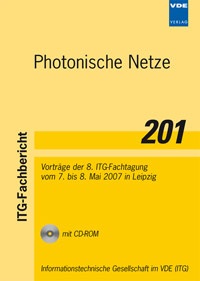Field trial on 107-Gbit/s transmission with pure electrical timedivision multiplex over 160 km
Konferenz: Photonische Netze - 8. ITG-Fachtagung
07.05.2007 - 08.05.2007 in Leipzig, Germany
Tagungsband: Photonische Netze
Seiten: 5Sprache: EnglischTyp: PDF
Persönliche VDE-Mitglieder erhalten auf diesen Artikel 10% Rabatt
Autoren:
Derksen, Rainer H. (Siemens Networks GmbH & Co. KG, MN PG NT CT 1, Otto-Hahn-Ring 6, D-81730 München, Germany)
Schubert, Colja (Fraunhofer Institute for Telecommunications, Heinrich-Hertz-Institut, Berlin, Germany)
Jansen, Sander (COBRA Institute, Eindhoven University of Technology, The Netherlands)
Zhou, Xiang; Birk, Martin (AT&T Labs - Research, Middletown, NJ 07748, USA)
Inhalt:
Electrical time-division multiplexing is the most cost-effective way to increase the transmission capacity of a single wavelength channel. Given the increasing importance of Ethernet-based data traffic there has recently been a strong interest to investigate the feasibility of 107-Gbit/s transmission with pure electrical timedivision multiplex as a basis for a future 100-Gbit/s Ethernet standard. The main challenge to realize 100-Gbit/s Ethernet is the development of cost-effective systems. Systems based on pure electrical timedivision mulitplex that furthermore are compatible with today’s channel spacing in the optical band used by wavelength-division multiplexing are therefore preferable. Meanwhile, for the transmission of 100-Gbit/s Ethernet different modulation formats have been examined, such as on-off keying, duobinary coding and differential quadrature-phase shift keying. The most straightforward implementation for 100-Gbit/s Ethernet that requires the least optical and electrical components is the on-off keying modulation format. Several investigations on 100-Gbit/s Ethernet have been published using this modulation format, however, so far no transmission experiment with pure electrical time-division multiplex both on the transmitting side and the receiving side has been reported. Here we report on the first 107-Gbit/s transmission with on-off keying and pure electrical time-division multiplex in the transmitter and receiver - namely over 160 km installed fiber in the network of a major American carrier. Besides the presentation of the achieved results, the still existing bottle necks - above all caused by the use of components which originally had been developed for operation with 40 Gbit/s or 80 Gbit/s only - are discussed. From this the resulting requirements for further research work are deduced. Furthermore we will show the measures applied to enable the transmission of 107-Gbit/s on-off keyed signals within a bandwidth of 100 GHz, required for the standard ITU-T channel spacing.


